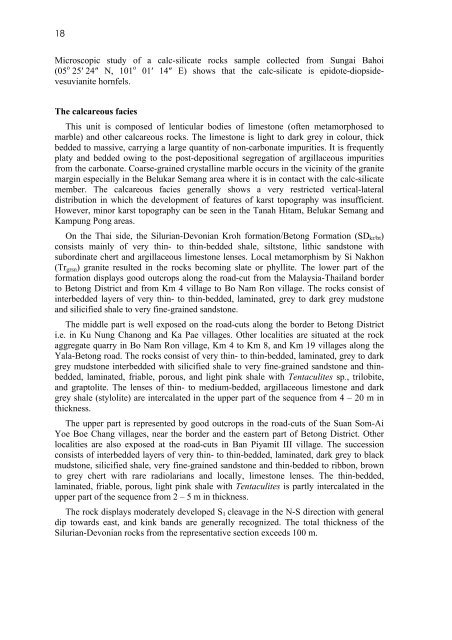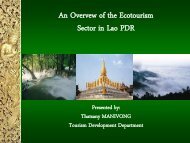GEOLOGY OF THE PENGKALAN HULU-BETONG TRANSECT ...
GEOLOGY OF THE PENGKALAN HULU-BETONG TRANSECT ...
GEOLOGY OF THE PENGKALAN HULU-BETONG TRANSECT ...
Create successful ePaper yourself
Turn your PDF publications into a flip-book with our unique Google optimized e-Paper software.
18<br />
Microscopic study of a calc-silicate rocks sample collected from Sungai Bahoi<br />
(05 o 25′ 24″ N, 101 o 01′ 14″ E) shows that the calc-silicate is epidote-diopsidevesuvianite<br />
hornfels.<br />
The calcareous facies<br />
This unit is composed of lenticular bodies of limestone (often metamorphosed to<br />
marble) and other calcareous rocks. The limestone is light to dark grey in colour, thick<br />
bedded to massive, carrying a large quantity of non-carbonate impurities. It is frequently<br />
platy and bedded owing to the post-depositional segregation of argillaceous impurities<br />
from the carbonate. Coarse-grained crystalline marble occurs in the vicinity of the granite<br />
margin especially in the Belukar Semang area where it is in contact with the calc-silicate<br />
member. The calcareous facies generally shows a very restricted vertical-lateral<br />
distribution in which the development of features of karst topography was insufficient.<br />
However, minor karst topography can be seen in the Tanah Hitam, Belukar Semang and<br />
Kampung Pong areas.<br />
On the Thai side, the Silurian-Devonian Kroh formation/Betong Formation (SDkr/bt)<br />
consists mainly of very thin- to thin-bedded shale, siltstone, lithic sandstone with<br />
subordinate chert and argillaceous limestone lenses. Local metamorphism by Si Nakhon<br />
(Trgrsn) granite resulted in the rocks becoming slate or phyllite. The lower part of the<br />
formation displays good outcrops along the road-cut from the Malaysia-Thailand border<br />
to Betong District and from Km 4 village to Bo Nam Ron village. The rocks consist of<br />
interbedded layers of very thin- to thin-bedded, laminated, grey to dark grey mudstone<br />
and silicified shale to very fine-grained sandstone.<br />
The middle part is well exposed on the road-cuts along the border to Betong District<br />
i.e. in Ku Nung Chanong and Ka Pae villages. Other localities are situated at the rock<br />
aggregate quarry in Bo Nam Ron village, Km 4 to Km 8, and Km 19 villages along the<br />
Yala-Betong road. The rocks consist of very thin- to thin-bedded, laminated, grey to dark<br />
grey mudstone interbedded with silicified shale to very fine-grained sandstone and thinbedded,<br />
laminated, friable, porous, and light pink shale with Tentaculites sp., trilobite,<br />
and graptolite. The lenses of thin- to medium-bedded, argillaceous limestone and dark<br />
grey shale (stylolite) are intercalated in the upper part of the sequence from 4 – 20 m in<br />
thickness.<br />
The upper part is represented by good outcrops in the road-cuts of the Suan Som-Ai<br />
Yoe Boe Chang villages, near the border and the eastern part of Betong District. Other<br />
localities are also exposed at the road-cuts in Ban Piyamit III village. The succession<br />
consists of interbedded layers of very thin- to thin-bedded, laminated, dark grey to black<br />
mudstone, silicified shale, very fine-grained sandstone and thin-bedded to ribbon, brown<br />
to grey chert with rare radiolarians and locally, limestone lenses. The thin-bedded,<br />
laminated, friable, porous, light pink shale with Tentaculites is partly intercalated in the<br />
upper part of the sequence from 2 – 5 m in thickness.<br />
The rock displays moderately developed S1 cleavage in the N-S direction with general<br />
dip towards east, and kink bands are generally recognized. The total thickness of the<br />
Silurian-Devonian rocks from the representative section exceeds 100 m.



